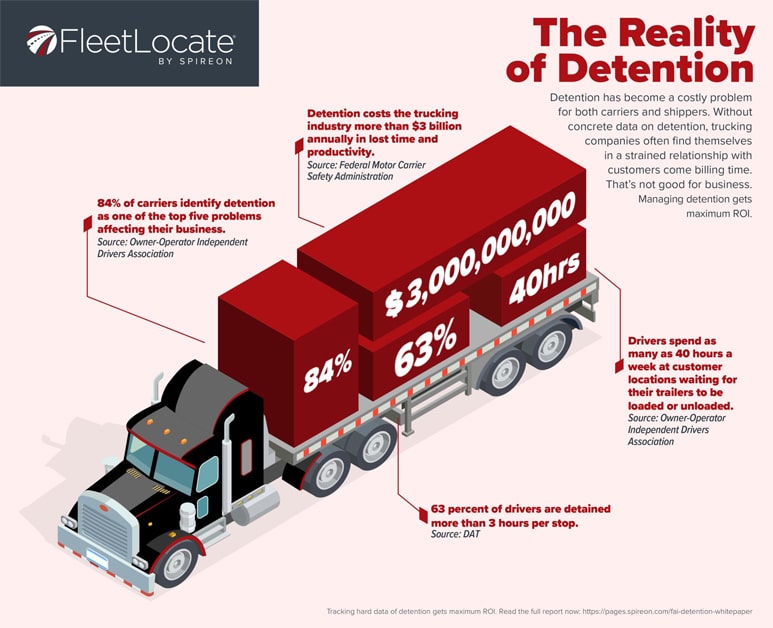If you’re in trucking, chances are you’ve already heard of layover and detention terms, and already know their meaning.
But if you’re new to trucking, and yet to start your career, this article will help you to get a basic understanding of layover and detention.
It’s important to know because sooner or later, you will come across these occurrences, and the knowledge will help you easily overcome such situations.
After all, layover and detention are common problems that truck drivers face. That should be a good reason to learn more about the topic.
Table of Contents
- What Is A Layover?
- How Much Is A Layover Pay On Average?
- What Is Detention?
- What causes detention in trucking?
- Can You Avoid Detention Time?
- How Much Is Detention Pay?
- How To Calculate Detention Fees?
- Final Thoughts
What Is A Layover?
A layover in trucking refers to a break taken by a truck driver while on a long-distance trip.
It typically occurs when a driver has to stop and wait for a specified amount of time before continuing the trip, usually due to regulations regarding driving hours or shipping schedules.
An example of a layover would be when a truck driver is required to take a mandatory 10-hour rest break after a certain number of hours on the road. During this time, the driver would stop driving and find a safe place to park their truck, rest and wait for the required amount of time to pass before continuing their trip.
Another example of a layover in trucking would be when a driver has to wait for a load to be loaded or unloaded at a shipment destination. The driver may have to wait several hours or even overnight for the load to be ready, during which time they would be on layover.
During a layover, the driver would find a safe place to park their truck, rest and wait until the load is ready to be transported.
How Much Is A Layover Pay On Average?
The average amount of layover pay in the trucking industry varies and is typically negotiated between the trucking company and the driver. It can range anywhere from $50 to $250 per day, with some companies offering a flat fee for each instance of layover.
The exact amount of layover pay can depend on various factors such as the company’s policies, the length of the layover, and the driver’s experience and qualifications.
To finalize, layover pay is not standardized and can vary greatly depending on the company and industry.
What Is Detention?

Detention in trucking refers to the time a truck driver must wait at a loading or unloading facility beyond the scheduled appointment time, without being able to leave.
This often results in a delay for the driver and can reduce their available driving hours for the day.
Detention pay is a form of compensation for this lost time and is typically paid by the shipper or receiver who caused the delay.
What causes detention in trucking?

Detention in trucking is caused by various factors that result in a delay for the truck driver at a loading or unloading facility.
Here are some common causes of detention in trucking include:
- Loading and unloading delays: long wait times at loading docks, customs or border crossings, or warehouses can result in detention.
- Paperwork and inspections: drivers may be detained while waiting for the necessary paperwork or inspections to be completed.
- Congestion at facilities: when there are too many trucks at a facility and not enough space for them to park, drivers may be forced to wait in line, leading to detention.
- Weather conditions: severe weather can cause delays and result in detention for drivers.
- Equipment malfunctions: breakdowns or maintenance issues with the truck or trailer can cause delays and result in detention.
These are just a few examples of the many factors that can lead to detention in trucking, and the exact causes can vary depending on the industry, location, and individual shipment.
Can You Avoid Detention Time?
There is no guarantee of avoiding detention time in trucking, but there are steps that can be taken to minimize it:
- Proper planning and scheduling: accurate scheduling and planning can help ensure that drivers arrive at loading and unloading facilities at the designated appointment time, reducing the likelihood of detention.
- Communication with shippers and receivers: open communication with shippers and receivers can help identify and resolve potential issues that may lead to detention, such as congestion at the facility or slow loading times.
- Use of technology: utilizing technology such as GPS tracking, electronic logging devices, and real-time communication tools can help to improve efficiency and reduce the likelihood of detention.
- Alternative routing: when possible, using alternative routes to bypass congested areas or facilities can help to reduce the risk of detention.
- Carrier selection: choosing carriers with a proven track record of timely delivery and minimal detention can also help to reduce the likelihood of detention.
These steps can help to minimize detention time in trucking, but it is important to keep in mind that detention is an inherent risk in the industry and cannot always be avoided.
How Much Is Detention Pay?
The average amount of detention pay in the trucking industry varies and is typically negotiated between the trucking company and the shipper or receiver.
It can range anywhere from $15 to $50 per hour, with some companies paying a flat fee for each instance of detention.
Some companies may also offer a reduced rate for longer periods of detention.
It’s important to note that detention pay is not standardized and can vary greatly depending on the company and industry.
How To Calculate Detention Fees?
The calculation of detention fees in the trucking industry varies and is typically negotiated between the trucking company and the shipper or receiver.
However, some common methods of calculating detention fees include:
- Hourly rate: a set hourly rate, such as $50 per hour, is charged for each hour the driver is detained beyond the agreed-upon time frame.
- Flat fee: a set flat fee, such as $100 per detention instance, is charged for each instance of detention.
- Tiered rate: a tiered rate system is used, where the fee increases based on the length of the detention. For example, $50 per hour for the first 2 hours, $75 per hour for the next 2 hours, and $100 per hour after that.
- Percentage of shipment value: a percentage of the shipment value is charged for each hour of detention, such as 2% of the shipment value per hour of detention.
It’s important to note that detention fee calculation is not standardized and can vary greatly depending on the company, industry, and the terms of the agreement between the trucking company and the shipper or receiver.
The method of calculation should be clearly defined and agreed upon in advance to avoid any misunderstandings or disputes.
Final Thoughts
If you’re looking for a new job in trucking, one of the possible questions to ask your potential employers is about layover and detention pay.
It’s an important aspect of any trucking business, and drivers should know how and how much they’ll be paid for layover and detention time.
Bear in mind that layover and detention pay differs from company to company, as that depends on the broker and the company itself.
Having any questions about layover and detention, feel free to ask in the comment section below.



